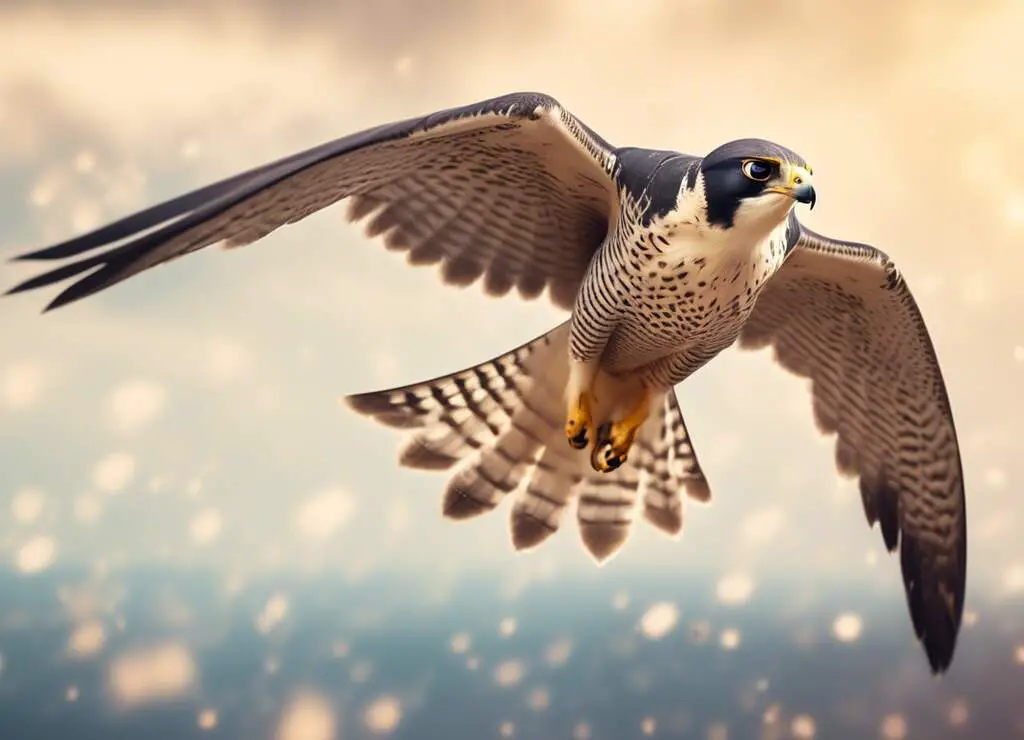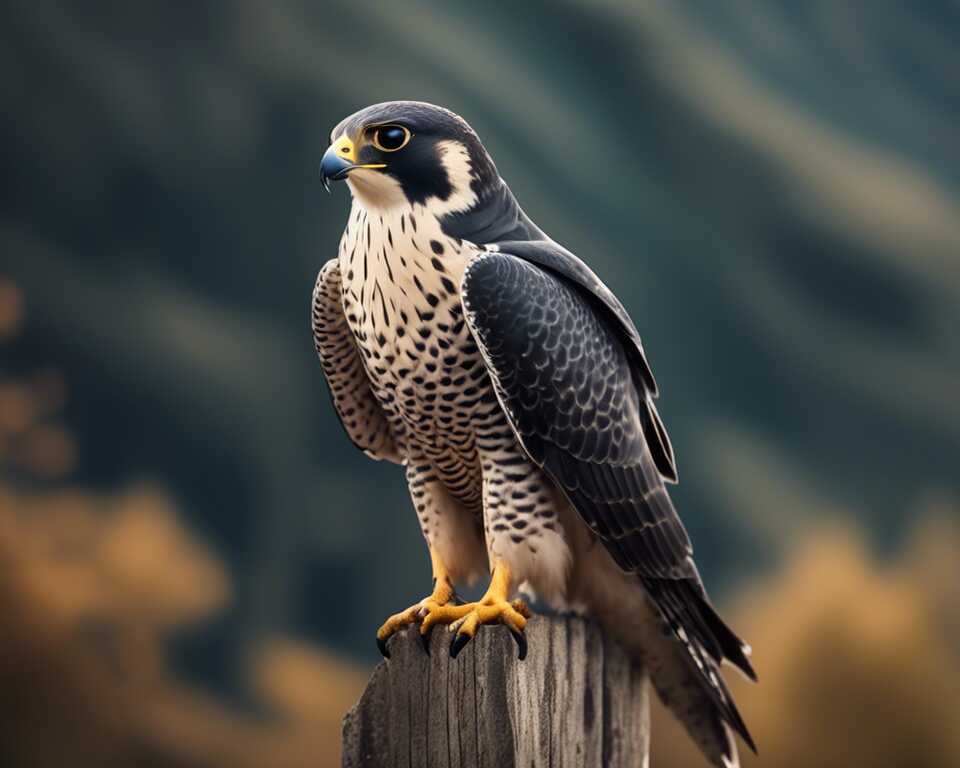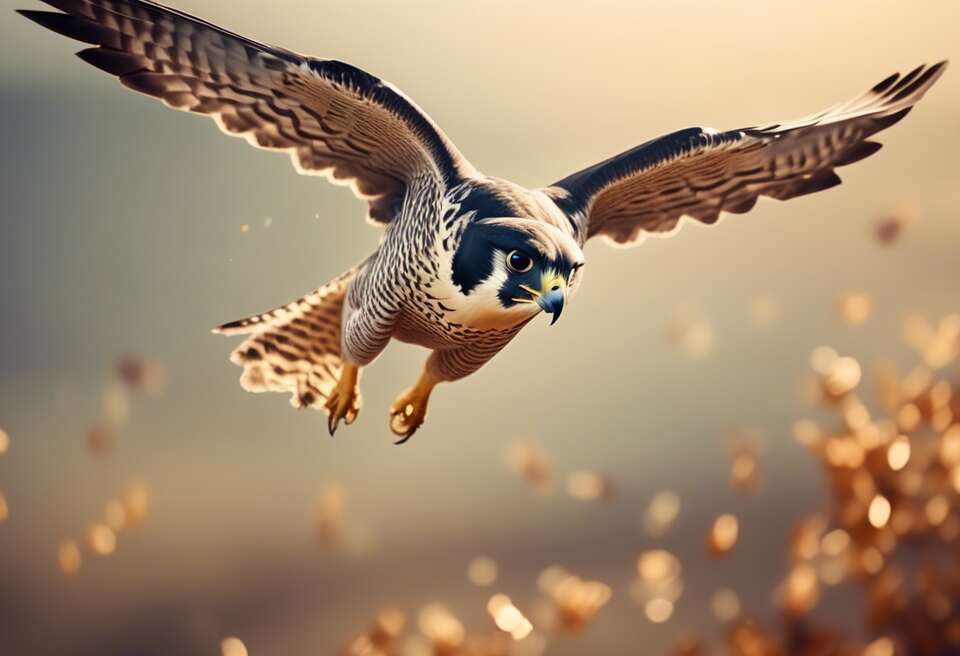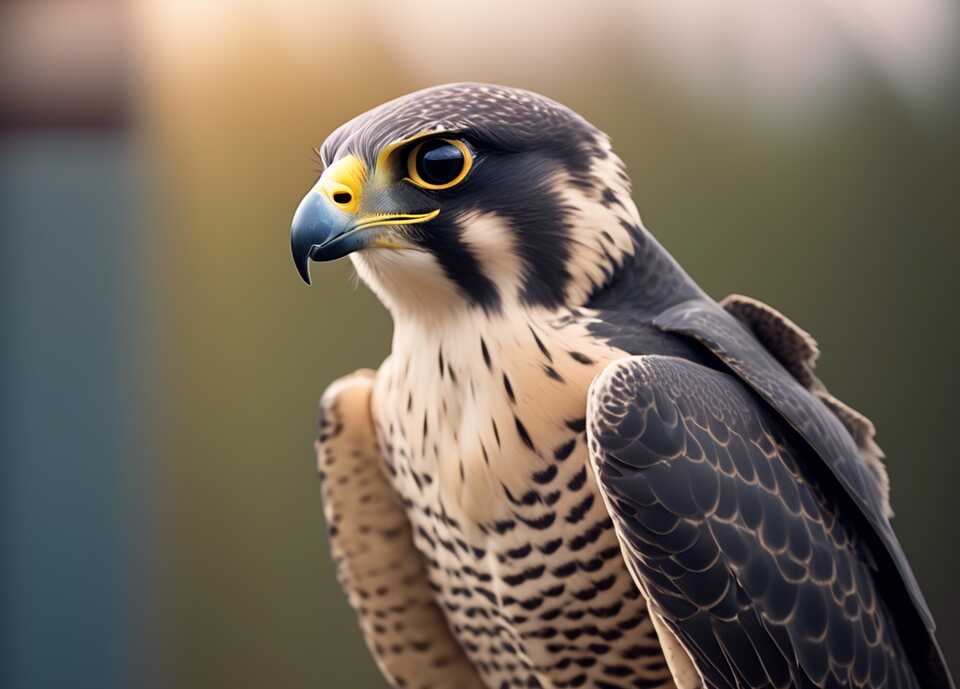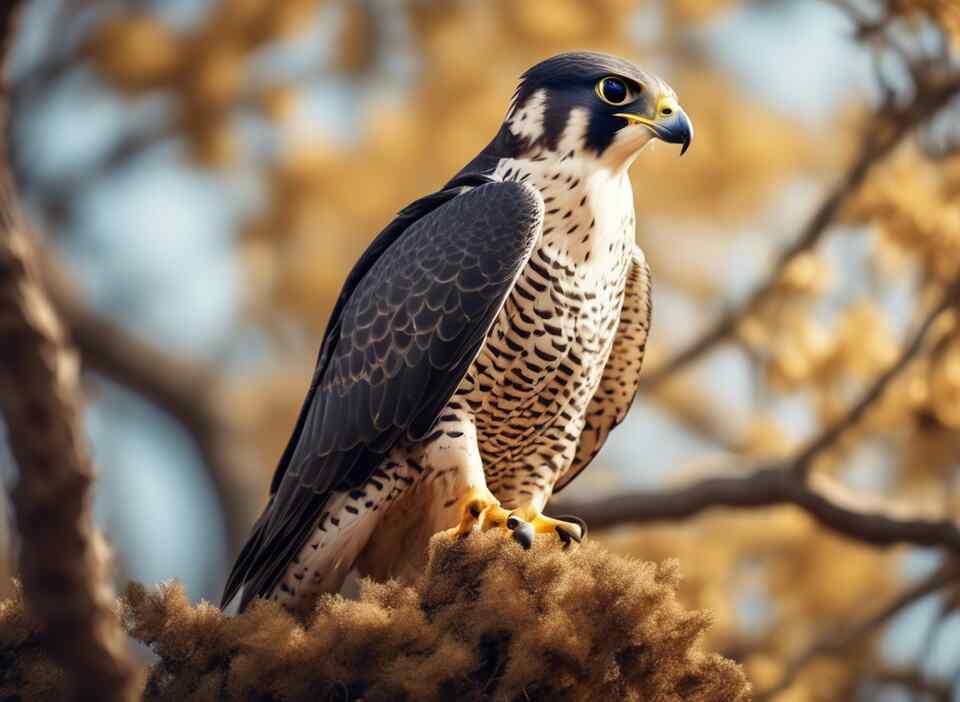Peregrine falcons are nature’s ultimate speed demons, reaching an astonishing 240 miles per hour in a dive. But speed isn’t their only superpower. With razor-sharp vision, unmatched agility, and a hunting style that leaves prey with no escape, these raptors dominate the skies. How do they achieve such incredible speeds? What makes them one of the most successful hunters on the planet? Let’s dive into the world of peregrine falcons and uncover their secrets.
Table of Contents
- 1 Peregrine Falcon (Overview)
- 2 Physical Characteristics: Built for Speed
- 3 The Peregrine’s Fame: Fastest Animal
- 4 Habitat and Distribution: Global Citizens
- 5 Diet & Hunting: Nature’s Perfect Predator
- 6 Breeding & Life Cycle: From Egg to Hunter
- 7 Peregrine Falcon Behavior: Beyond the Hunt
- 8 Conservation Status: A Comeback Story
- 9 Cultural Significance: More Than Just a Bird
- 10 Observing Peregrines: Tips for Beginners
- 11 Peregrine Falcons in Research
- 12 Peregrine Falcons & Climate Change
- 13 Peregrine Falcons: Conservation & Education
- 14 The Future of Peregrines: Challenges & Prospects
- 15 Conclusion
- 16 Author
Peregrine Falcon (Overview)
The Peregrine Falcon (Falco peregrinus) is a bird of prey that belongs to the family Falconidae. Its name comes from the Latin word “peregrinus,” meaning “wanderer” or “pilgrim,” which aptly describes this bird’s widespread global distribution and migratory habits.
Key Facts:
- Scientific Name: Falco peregrinus
- Family: Falconidae
- Global Population: Estimated 140,000 breeding pairs
- Wingspan: 74-120 cm (29-47 inches)
- Weight: 530-1600 g (19-56 oz)
- Lifespan: Up to 15-20 years in the wild
Taxonomy and Related Species
The Peregrine Falcon belongs to the genus Falco, which includes about 40 species. Some closely related species include:
- Gyrfalcon (Falco rusticolus)
- Saker Falcon (Falco cherrug)
- Lanner Falcon (Falco biarmicus)
- Prairie Falcon (Falco mexicanus)
Understanding these relationships helps us appreciate the diversity within the falcon family and the unique adaptations of each species.
Physical Characteristics: Built for Speed
When I first saw a Peregrine Falcon up close during a wildlife rehabilitation program, I was struck by its compact yet powerful build. Every aspect of this bird’s anatomy seems designed for one purpose: speed.
The Aerodynamic Marvel
Peregrine Falcons possess several physical adaptations that contribute to their exceptional flying abilities:
- Streamlined body: Their sleek, teardrop-shaped body minimizes air resistance during high-speed dives.
- Powerful chest muscles: These provide the strength needed for rapid acceleration and maneuvering.
- Long, pointed wings: Perfect for both soaring and diving, these wings can be tucked close to the body during stoops (high-speed dives).
- Stiff tail feathers: These act as a rudder, allowing precise control during high-speed flight.
The Falcon’s Arsenal
The Peregrine’s hunting equipment is equally impressive:
- Sharp, hooked beak: Designed for tearing prey apart efficiently.
- Large eyes: Provide excellent vision, crucial for spotting prey from great distances.
- Strong talons: Used to catch and kill prey mid-air.
One of the most fascinating adaptations I learned about is the small bony protrusion in their nostrils called a tubercle. This structure helps to deflect air pressure during high-speed dives, allowing the falcon to breathe normally even when traveling at incredible speeds.
Vision: A Hunter’s Most Valuable Asset
Peregrine Falcons possess some of the most acute vision in the animal kingdom. Their visual acuity is estimated to be 2.6 times sharper than that of humans. This exceptional eyesight allows them to spot a bird from up to 5 miles away.
- High density of photoreceptors: Their retinas have more light-sensitive cells per area than humans.
- Tetrachromatic vision: They can see in the ultraviolet spectrum, in addition to the colors visible to humans.
- Pecten oculi: A comb-like structure in the eye that provides nutrition to the retina and may enhance motion detection.
This incredible vision allows Peregrines to spot prey from over 8 kilometers away, giving them a significant advantage in hunting.
The Peregrine’s Fame: Fastest Animal
If there’s one fact that never fails to impress people about Peregrine Falcons, it’s their speed. These birds hold the record for the fastest animal on the planet, reaching speeds that would leave even the quickest cheetah in the dust.
Breaking Down the Numbers
Here’s a table summarizing the speeds of the Peregrine Falcon in different contexts:
| Speed Type | Speed | Context |
|---|---|---|
| Diving (stooping) | Up to 389 km/h (242 mph) | Fastest recorded speed |
| Level flight | 40-60 km/h (25-37 mph) | Cruising speed |
| Flapping flight | Up to 100 km/h (62 mph) | Maximum horizontal speed |
To put this into perspective, if a Peregrine Falcon were to race against a Formula 1 car at its top diving speed, the falcon would win. It’s a humbling reminder of the incredible feats nature is capable of.
The Physics of the Dive
The Peregrine’s incredible diving speed is a result of both its physical adaptations and the physics of its descent. During a stoop, the falcon:
- Tucks its wings close to its body, creating a teardrop shape
- Angles its descent to balance speed and control
- Uses its tail feathers for minute adjustments
As it accelerates, the falcon approaches terminal velocity – the speed at which air resistance prevents further acceleration. For a Peregrine, this speed is much higher than for other birds due to its aerodynamic shape.
Habitat and Distribution: Global Citizens
One of the most remarkable things about Peregrine Falcons is their adaptability. These birds can be found on every continent except Antarctica, making them one of the most widespread bird species in the world.
Natural Habitats
In their natural environment, Peregrine Falcons prefer:
- Coastal cliffs
- Mountain ranges
- River valleys
- Tundra regions
Urban Adaptations
What fascinates me most is the Peregrine’s ability to thrive in urban environments. In cities, they’ve swapped cliff faces for skyscrapers, turning our concrete jungles into their hunting grounds. I’ve personally observed nesting pairs on cathedral spires and office buildings, a testament to their incredible adaptability.
Global Distribution
Peregrine Falcons have an impressive global range. Some notable populations include:
- North America: Found across the continent, with notable recoveries in many urban areas.
- Europe: Present in most countries, with strong populations in the UK and Scandinavia.
- Asia: Breeds across northern Asia and winters in southern regions.
- Australia: Home to the subspecies Falco peregrinus macropus.
- Africa: Migratory populations winter in sub-Saharan Africa.
This wide distribution has led to the evolution of several subspecies, each adapted to its specific environment.
Diet & Hunting: Nature’s Perfect Predator
Watching a Peregrine Falcon hunt is like witnessing a perfectly choreographed aerial ballet. These birds have honed their hunting skills to near perfection, making them one of the most efficient predators in the animal kingdom.
The Peregrine’s Menu
Peregrine Falcons are primarily bird hunters, with a diet that includes:
- Pigeons and doves
- Waterfowl
- Songbirds
- Waders
- Occasionally small mammals and insects
The Art of the Stoop
The falcon’s hunting technique, known as the “stoop,” is a marvel of natural engineering:
- Spotting prey: Using their exceptional eyesight, they locate potential targets from high altitudes.
- The climb: They ascend to heights of up to 1000 meters (3300 feet).
- The dive: With wings tucked, they enter a near-vertical dive.
- The strike: Just before impact, they open their talons to strike the prey mid-air.
- The catch: If successful, they carry their prey to a perch to feed.
This high-speed attack often renders the prey unconscious on impact, showcasing both the falcon’s hunting efficiency and the incredible forces at play during these dives.
Hunting Adaptations
Peregrine Falcons have several specific adaptations that make them exceptional hunters:
- Notched beak: Helps sever the prey’s spine quickly and humanely.
- Specialized feet: With long toes and sharp talons for gripping prey in flight.
- Rapid digestion: Allows them to process food quickly and maintain a light weight for flight.
Feeding Behavior
After a successful hunt, Peregrines typically carry their prey to a favorite perch, known as a plucking post. Here, they carefully remove feathers before consuming their meal. This behavior not only makes the prey easier to eat but also helps avoid ingesting indigestible parts.
Breeding & Life Cycle: From Egg to Hunter
Understanding the Peregrine Falcon’s life cycle gives us insight into their population dynamics and conservation needs.
Courtship and Nesting
Peregrine Falcons typically mate for life, with courtship involving impressive aerial displays. Their nesting sites, called eyries, are usually located on high cliffs or tall buildings in urban areas.
Courtship behaviors include:
- Aerial acrobatics: Males perform spectacular flight displays to attract females.
- Food offerings: Males bring food to females as part of the courtship ritual.
- Mutual preening: Pairs bond by grooming each other.
The Breeding Cycle
- Egg-laying: 3-4 eggs laid at 2-3 day intervals
- Incubation: 29-32 days, shared by both parents
- Hatching: Chicks hatch asynchronously
- Fledging: Young falcons leave the nest at 35-42 days old
- Independence: Achieved at about 2 months after fledging
Watching falcon chicks develop from helpless hatchlings to skilled flyers is a reminder of the incredible journey these birds undergo in a relatively short time.
Parental Care
Both male and female Peregrines participate in parental care:
- Incubation: Primarily done by the female, with the male providing food.
- Brooding: Female broods young chicks while the male hunts.
- Feeding: Both parents feed the chicks, tearing food into small pieces.
- Defense: Parents vigorously defend the nest against intruders.
Juvenile Development
Young Peregrines go through several stages of development:
- Nestling stage: Chicks are covered in white down, gradually replaced by juvenile feathers.
- Branching stage: Young birds explore areas near the nest, exercising wings.
- Fledging: First flights are taken, often with awkward landings.
- Hunting practice: Parents teach young to hunt through demonstrations and food drops.
Peregrine Falcon Behavior: Beyond the Hunt
While hunting is a crucial aspect of Peregrine behavior, these birds exhibit a range of other interesting behaviors.
Communication
Peregrines use a variety of vocalizations and body language to communicate:
- Cacking: A rapid, high-pitched call used in territorial defense.
- Wailing: A long, drawn-out call often used during courtship.
- Chittering: A soft, conversational sound between mates or parents and offspring.
- Body postures: Various poses indicate aggression, submission, or readiness to mate.
Migration
Many Peregrine populations are migratory, undertaking impressive journeys each year:
- Arctic breeders: Travel to South America for the winter.
- European populations: Often winter in Africa.
- Urban populations: May be resident year-round if food is available.
During migration, Peregrines can cover impressive distances, with some individuals traveling over 25,000 km annually.
Intelligence and Learning
Peregrine Falcons demonstrate remarkable intelligence and adaptability:
- Problem-solving: They can devise new hunting strategies for novel prey.
- Tool use: Some individuals have been observed using objects to manipulate their environment.
- Social learning: Young falcons learn complex hunting techniques from their parents.
Conservation Status: A Comeback Story
The story of the Peregrine Falcon’s conservation is one of the most inspiring in the world of wildlife protection. It’s a tale of near-extinction and remarkable recovery that gives hope for other endangered species.
The DDT Crisis
In the mid-20th century, Peregrine Falcon populations plummeted due to the widespread use of DDT pesticides. This chemical caused eggshell thinning, leading to widespread breeding failure. By the 1970s, Peregrines were extinct in many parts of their range.
The Road to Recovery
Thanks to concerted conservation efforts, including:
- Ban on DDT use
- Captive breeding programs
- Reintroduction initiatives
- Legal protections
Peregrine Falcon populations have made a remarkable recovery. Today, their conservation status is “Least Concern” according to the IUCN Red List.
Conservation Techniques
Several innovative techniques were used in Peregrine conservation:
- Hacking: A method of releasing captive-bred young to the wild.
- Cross-fostering: Placing Peregrine eggs in the nests of other raptor species.
- Artificial nest sites: Creating nesting platforms on buildings and bridges.
- Satellite tracking: Monitoring migration patterns and habitat use.
Ongoing Challenges
Despite their recovery, Peregrines still face threats:
- Habitat loss: Particularly in developing countries.
- Climate change: Affecting prey availability and breeding patterns.
- Collisions: With man-made structures, especially during migration.
- Persecution: Still hunted illegally in some regions.
Cultural Significance: More Than Just a Bird
Throughout history, Peregrine Falcons have held a special place in human culture, particularly in the art of falconry.
Falconry: An Ancient Art
Falconry, the practice of using birds of prey to hunt, has been practiced for thousands of years. Peregrine Falcons, with their speed and hunting prowess, have long been prized by falconers. This practice has not only influenced human-falcon interactions but has also contributed to our understanding and conservation of these birds.
Key aspects of falconry with Peregrines include:
- Training: A complex process involving positive reinforcement and trust-building.
- Equipment: Specialized gear like jesses, hoods, and gloves.
- Hunting techniques: Falconers and falcons work as a team to pursue game.
- Conservation role: Modern falconers often contribute to breeding and release programs.
Symbols of Speed and Freedom
In modern times, Peregrine Falcons have become symbols of speed, freedom, and urban wildlife adaptation. They’ve been featured on:
- Postage stamps in numerous countries
- Coins and banknotes
- Corporate logos
- Sports team mascots
Peregrines in Literature and Art
These magnificent birds have inspired countless works of art and literature:
- “The Once and Future King” by T.H. White features falconry prominently.
- “H is for Hawk” by Helen Macdonald explores the author’s relationship with a Goshawk, often comparing it to Peregrines.
- Paintings by John James Audubon and other wildlife artists often depict Peregrines.
Observing Peregrines: Tips for Beginners
If you’re inspired to observe these magnificent birds in the wild, here are some tips to get you started:
- Research local populations: Many cities have well-known Peregrine nesting sites.
- Visit during breeding season: Spring and early summer offer the best chances to see active nests.
- Bring binoculars: Falcons often perch high up, so good optics are essential.
- Be patient: Like all wildlife watching, patience is key.
- Respect their space: Always observe from a distance to avoid disturbing the birds.
Best Observation Locations
While Peregrine Falcons can be found in various habitats, some locations offer better chances for observation:
- Urban environments: Many cities have well-known nesting sites on tall buildings or bridges. For example:
- New York City: Several pairs nest on skyscrapers and bridges
- London: The Tate Modern and other landmarks host nesting falcons
- Chicago: Nesting pairs can be found on several downtown buildings
- Coastal cliffs: Natural nesting sites often provide spectacular viewing opportunities:
- Dover cliffs, UK
- Big Sur, California
- Acadia National Park, Maine
- Inland cliffs and canyons:
- Grand Canyon, Arizona
- Yosemite National Park, California
- Migration hotspots: During spring and fall migrations, certain locations see high concentrations of Peregrines:
- Cape May, New Jersey
- Hawk Mountain, Pennsylvania
- Kekoldi, Costa Rica
Ethical Observation Practices
When observing Peregrine Falcons, it’s crucial to follow ethical guidelines to ensure the birds’ well-being:
- Maintain distance: Use binoculars or spotting scopes to observe from afar.
- Avoid disturbing nests: Never approach active nest sites, especially during breeding season.
- Follow local regulations: Many nesting sites have specific viewing guidelines.
- Limit photography: If photographing, use long lenses and never use flash near nests.
- Leave no trace: Always practice responsible wildlife viewing by not leaving any impact on the environment.
Peregrine Falcons in Research
Scientific research on Peregrine Falcons has not only improved our knowledge of the species but has also contributed to broader fields of study.
Ecotoxicology Studies
The Peregrine’s near-extinction due to DDT played a crucial role in understanding the environmental impacts of pesticides:
- Biomagnification: Peregrines, as top predators, accumulate high levels of environmental toxins.
- Eggshell thinning: Studies on Peregrine eggs helped establish the link between DDT and reproductive failure.
- Recovery monitoring: Ongoing research tracks the presence of environmental contaminants in recovering populations.
Flight Dynamics Research
The Peregrine’s incredible flight capabilities have inspired numerous studies:
- High-speed dive mechanics: Research into the aerodynamics of the stoop has applications in aircraft design.
- Vision studies: Understanding how Peregrines track prey at high speeds informs human visual processing research.
- Energy efficiency: Studies on Peregrine flight efficiency contribute to broader research on animal locomotion.
Urban Ecology
As urban adapters, Peregrines provide valuable insights into wildlife in human-dominated landscapes:
- Adaptation studies: Research on how Peregrines adapt to urban environments informs urban wildlife management.
- Human-wildlife conflict: Studies on Peregrine interactions with urban pigeons and other birds help in managing urban ecosystems.
- Urban conservation: Successful urban Peregrine populations demonstrate the potential for wildlife conservation in cities.
Peregrine Falcons & Climate Change
As global temperatures rise and weather patterns shift, Peregrine Falcons face new challenges and opportunities.
Observed Impacts
Research has already documented several effects of climate change on Peregrine populations:
- Shifting ranges: Some populations are moving northward or to higher elevations.
- Changed migration patterns: Some migratory populations are altering their timing or becoming more sedentary.
- Prey availability: Changes in prey species’ distributions and abundance affect Peregrine hunting success.
Potential Future Impacts
Scientists predict several potential long-term effects of climate change on Peregrines:
- Habitat loss: Sea-level rise may affect coastal nesting sites.
- Extreme weather: Increased frequency of severe storms could impact breeding success.
- Competition: Range shifts may bring Peregrines into competition with other raptor species.
Adaptive Capacity
Despite these challenges, Peregrine Falcons have several characteristics that may help them adapt to climate change:
- Dietary flexibility: Their ability to hunt a wide range of prey species provides some resilience.
- Habitat generalists: Peregrines can adapt to various environments, including urban areas.
- High dispersal ability: Their capacity for long-distance movement may help them track shifting habitats.
Peregrine Falcons: Conservation & Education
While wild Peregrines are the focus of most conservation efforts, captive individuals play important roles in education and research.
Rehabilitation Centers
Wildlife rehabilitation centers often care for injured Peregrine Falcons:
- Injury treatment: Common issues include collisions with buildings and vehicles.
- Rehabilitation: Preparing recovered birds for release back to the wild.
- Non-releasable individuals: Some birds unable to return to the wild become education ambassadors.
Zoos and Wildlife Centers
Many zoos and wildlife centers house Peregrine Falcons:
- Education programs: Captive Peregrines help teach the public about raptors and conservation.
- Breeding programs: Some facilities participate in captive breeding for conservation purposes.
- Research: Captive birds allow for close study of Peregrine biology and behavior.
Falconry Birds
While controversial, some argue that falconry birds contribute to conservation:
- Public engagement: Falconry demonstrations raise awareness about raptors.
- Hands-on conservation: Some falconers participate in captive breeding and release programs.
- Traditional knowledge: Falconry practices preserve historical knowledge about Peregrine behavior and care.
The Future of Peregrines: Challenges & Prospects
While the recovery of Peregrine Falcons is a conservation success story, these birds still face challenges in our rapidly changing world.
Ongoing Threats
- Habitat loss: Continued urban development and land-use changes threaten some Peregrine habitats.
- Collisions: Man-made structures, particularly glass buildings and wind turbines, pose collision risks.
- Illegal trade: Some populations still face pressure from illegal capture for the pet trade or falconry.
- Emerging contaminants: New environmental pollutants may pose unforeseen threats.
Conservation Opportunities
- Urban planning: Bird-friendly building designs can reduce collision risks.
- Artificial nest sites: Continued installation and maintenance of urban nest boxes support breeding populations.
- Citizen science: Engaging the public in Peregrine monitoring programs increases data collection and public awareness.
- International cooperation: Coordinated efforts along migration routes can protect Peregrines throughout their range.
Technological Advancements
New technologies offer exciting possibilities for Peregrine research and conservation:
- GPS tracking: High-resolution tracking devices provide detailed data on movement and behavior.
- Genetic studies: Advanced genetic techniques help manage captive breeding programs and monitor wild population health.
- Drone monitoring: UAVs allow for less intrusive nest monitoring in difficult-to-access locations.
- Artificial intelligence: Machine learning algorithms can help process large amounts of observational data.
Conclusion
Peregrine falcons are truly the kings of the sky, blending speed, precision, and unparalleled hunting skills to become one of nature’s most remarkable predators. Their incredible speed, combined with their sharp instincts and adaptability, allows them to thrive in a variety of environments, from city skyscrapers to remote cliffs.
Understanding their unique characteristics not only highlights their status as nature’s aerial athletes but also reminds us of the importance of preserving these incredible birds for future generations. Whether soaring above or diving at lightning speed, peregrine falcons will always be a symbol of the power and beauty of the wild.

